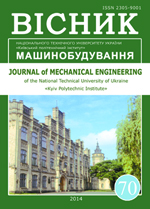IMPACT DAMAGE TO THE FIBULA IN THE LOWER LIMB DEFORMATION UNDER EXTERNAL LOADS
DOI:
https://doi.org/10.20535/2305-9001.2014.70.35346Keywords:
Experimental biomechanics, fibula, “shin-foot” complex, stiffness, static and cyclic loadingsAbstract
Purpose. Based on experimental studies of biomechanical characteristics of lower limb under axial (static and cyclic) loads determine the effect of the level and nature of damage fibula on stability and overall stiffness of the “shin-foot” complex in general.
Design/methodology/approach. Using 8 fresh-frozen lower limbs examples (“shin-foot” complex) and universal examining machine TIRAtest-2151 we studied axial static and cyclic loadings of ankle at changes of foot’s position (neutral, dorsal extension, plantar flexion, inversion, eversion) and modeled fibula injuries (osteotomy and resection of middle and lower thirds thereof), tibia bone is intact. Software control testing machine TIRA-test reproduces the cyclic loading of samples while maintaining the specified minimum and maximum values of power during certain periods of time. With this program performed cyclic loading and unloading cycled between two given values force from 100 to 800 N with the number of cycles to 50.
Findings. 1. The modeled lower and middle third of fibula injures, do not cause critical decrease of “shin-foot” complex load bearing capacity. 2. Deformation under cyclic loads more sensitive to the state of the “shin-foot” complex than in single loads. This property should be used in biomechanics in the development of programs for evaluating the quality of fixation of fracturesReferences
1. Pomylkytauskladnennyaprylikuvannidystalnogoepimetafizukistokgomilky.O.A.Buryanov, V.P.Kvasha, M.M.Ayub [tain.] [tain.].Litopystravmatologiitaortopedii. 2008. No 1–2. P. 79–82.
2. LitunYu.M., ShydlowskyM.S. Deformuvannyanyjnyoyikintsivkypiddiyeyuosyovyhnavantajenprymodelyovanyhushkodzhennyahmalogomilkovoyikistky. Visnykortopedii, travmatologiitaprotezuvannya. 2012. No 1. P. 69–71.
3. LyabahA.P. KlinichnadiagnostykadeformatsiyistopyZAT «AtlantYUEMCI», 2003. p. 110.
4. CanaleS. T. Canale & Beaty: Campbell'sOperativeOrthopaedics, 11thed. / S. T. Canale, J. H. Beaty. Philadelphia: ElsevierInc., 2008. 4902 P.
5. Distal fibular length needed for ankle stability / E. Uchiyama, D. Suzuki , H. Kura [et al.] // Foot & ankle international. 2006. Vol. 27, No 3. P. 185–189.
6. Externalfixationoftibialplafondfractures: isroutineplatingofthefibulanecessary.T. M. Williams, J. L. Marsh, J. V. Nepola [tain.] // Journaloforthopaedictrauma. 1998. Vol. 12, No 12. P. 16–20.
7. French B. High-energy tibial shaft fractures / B. French, P. Tornetta // Orthopedic clinics of North America. 2002. Vol. 33, No 1. P. 211–230.
8. Logan А. L. The foot and ankle: clinical applications / А. L. Logan. Gaithersburg, Maryland. Aspen Publishers, 1995. 185 p.
9. The effect of concurrent fibular fracture on the fixation of distal tibia fractures: A laboratory comparison of intramedullary nails with locked plates / E. J. Strauss, D. Alfonso, F.J. Kummer [et al.]. Journal of orthopaedic trauma. 2007. Vol. 21, No3. p. 172–177.
10. The role of fibular fixation in combined fractures of the tibia and fibula: a biomechanical investigation. T. G. Weber, R. M. Harrington, M. B. Henley [et al.]. Journal of orthopaedic trauma. 1997. Vol. 11, No3. p. 206–211.
11. ShydlowskyN.S., LakshaA.M., ShpakD.E. Naturnyeispytaniyasystem «bolshebertsovayakostsperelomom – sterzhnevoyapparatfiksatsii» VisnykNatsionalnogotekhnichnogouniversytetuUkrayiny «Kyivskiypolitekhnichnyinstytut», SeriyaMashinobuduvannya, К: 2011, No 61, 2. p. 134 –140.

